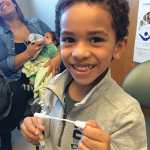In a separate survey related to the same trials, the families and children rated their experience in the CPT study very positively, while children in studies requiring two CPT exposures rated their experiences even more positively.
Ali said that, despite the above findings, federal regulations can be challenging to apply in the world of pediatric pain research. The regulations say that nontherapeutic pediatric research can be approved if there’s minimal risk, defined as the probability and likelihood of possible harm being no greater than that encountered by participants in everyday life. If there’s more risk than that, the prospect for direct benefit is generally needed. But if there’s no direct benefit possible, then there can only be a “minor increase over minimal risk,” and the study has to be likely to yield “generalizable knowledge about subjects’ ‘condition,’ which is of ‘vital’ importance.”
These parameters are open to interpretation, Ali said, and researchers must also be mindful of state laws that may provide additional protections for pediatric research participants. As always, he said, the risk of harms in pediatric research must be weighed against potential benefits, and while the regulations do create important boundaries for pediatric pain research, they are not meant to stand in the way of acceptable forms of research—both therapeutic and nontherapeutic. Ultimately, each study must be evaluated on a case-by-case basis.
“Despite the challenges,” Ali said, “I think, at least at the institutional level, many have managed to evaluate well-designed and justifiable pain research studies fairly and in a way that’s, I think, more understanding [of the patient’s perspective].”
Thomas Collins is a freelance medical journalist based in Florida.
References
- Harreby M, Neergaard K, Hesselsøe G, Kjer J. Are radiologic changes in the thoracic and lumbar spine of adolescents risk factors for low back pain in adults? A 25-year prospective cohort study of 640 school children. Spine. 1995;20:2298-2302.
- Jones GT, Silman AJ, Power C, Macfarlane GJ. Are common symptoms in childhood associated with chronic widespread body pain in adulthood? Results from the 1958 British Birth Cohort Study. Arthritis Rheum. 2007;56:1669-1675.
- Logan DE, Simons LE, Stein MJ, Chastain L. School impairment in adolescents with chronic pain. J Pain. 2008;9:407-416.
- Konijnenberg AY, Uiterwaal CS, Kimpen JL, van der Hoeven J, Buitelaar JK, de Graeff-Meeder ER. Children with unexplained chronic pain: Substantial impairment in everyday life. Arch Dis Child. 2005;90:680-686.
- Birnie KA, Noel M, Chambers CT, von Baeyer CL, Fernandez CV. The cold pressor task: Is it an ethically acceptable pain research method in children? J Pediatr Psychol. 2011;36:1071-1081.

